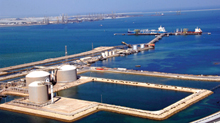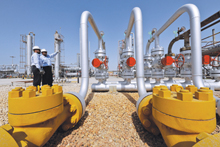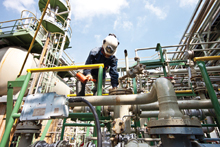
 Hughes tank shower
Hughes tank shower
MAINTAINING a safe water temperature is essential if emergency safety showers are to be used properly. If the water is too hot it could cause serious injury and at the very least, prevent casualties remaining under the shower long enough to complete the decontamination process, says a spokesman for Hughes Safety Showers, a Sharjah-based company.
In the oil and petrochemical industries tank showers are a popular choice for sites where the mains water supply is inadequate, unreliable or simply not available. In hot climates, the temperature of the water stored in the tank can easily rise making the shower unusable. Consequently, some form of cooling is required.
According to the ANSI Z 358.1 2009 standard, an emergency safety shower should deliver tepid water and that means a temperature between 16 deg and 38 degC. It also recommends a minimum flow of 75 litres (20 US gallons) a minute for at least 15 minutes, he says.
Insulation alone is rarely sufficient so manufacturers also use some form of mechanical cooling system.
Hughes Safety Showers, for example, offers a compact and highly efficient chiller unit which can be attached to the side of the tank. Water constantly circulates through the chiller and when the temperature starts to rise the unit switches on to keep it within the safe limits. The chiller can be supplied as part of a new shower or easily retrofitted to existing units. Flame proof versions are also available for zone 1 hazardous areas but the additional weight and size of these units usually means they are mounted on the floor alongside the shower. Where high temperatures during the day are followed by cold nights it may also be necessary to fit an immersion heater in the tank, he says.
Regular testing by operating the shower every week is important to make sure it is working properly. Testing can also help to minimise the risk of contracting legionnaires’ disease. The bacterium that causes legionnaires’ disease can be found in static water at temperatures between 20 deg and 45 deg C. Draining water from the tank during testing will help to prevent contamination, he says.
With a tank shower permanently connected to the mains, fitting a siphon dump valve can also help. Water constantly runs into the tank gradually raising the volume above the specified capacity. When it reaches a predetermined point the valve automatically opens and the excess water is discharged. The introduction of fresh water and the turbulence caused by the discharge helps to reduce the risk of legionella contamination, he says.
Temperature control in tank showers is vitally important if they are to be used safely. Discussing site requirements early with an experienced supplier of equipment, such as Hughes, will ensure you get the most effective and cost-efficient solution.












































































.jpg)



